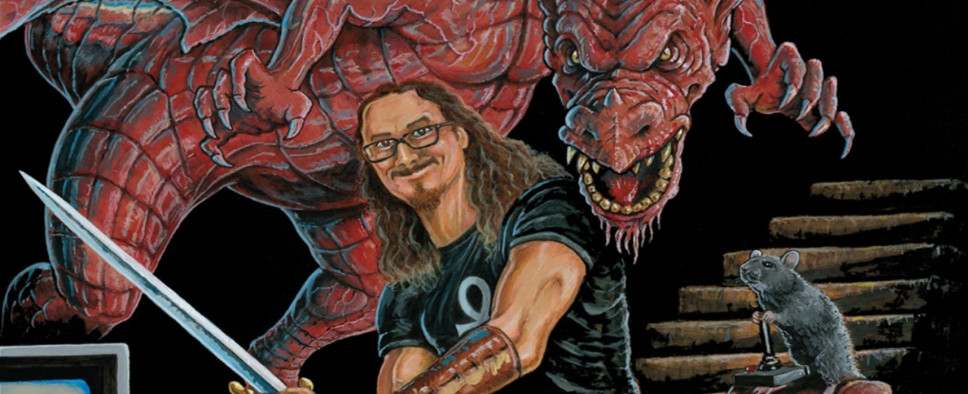Dungeons & Desktops: The History of Computer Role-Playing Games - Second Edition Review - Page 2
-
Category: ReviewsHits: 16265

Article Index
Poul Anderson's Three Hearts and Three Lions, for example, basically invented the concept of a fantasy paladin, the regenerating trolls and their fire vulnerability, and the famous Lawful - Chaotic alignment system. Jack Vance's Dying Earth series originated the slot-based spellcasting system and featured a setting that combined fantasy and science fiction elements, much like many of the early CRPGs did. And of course who could forget Robert E. Howard's Conan stories. Dungeons & Desktops references Conan a few times as an example of the classic warrior, but it skips past the fact that many of Howard's stories featuring the character pretty much establish every single convention of the dungeon-crawling subgenre of CRPGs.
Now, from listening to Shane's show, I know for a fact he's familiar with those books, and as such seeing Dungeons & Desktops gloss over their contribution to RPGs was somewhat surprising.
Moving past that, the rest of the book is separated into several ages, with a couple of chapters dedicated to JRPGs as their own unique thing. Each of those ages is represented by a number of highly influential and memorable games. This gives us an opportunity to learn all about those titles, their long-lasting legacy and the people, and companies, that created them.
Personally, I'm fairly knowledgeable when it comes to CRPGs released after about 1994. As such, the early history of CRPGs was of particular interest to me, and Dungeons & Desktops didn't disappoint there. After reading the book I can safely say that I now know way more about those mystery-shrouded early years of one-man passion projects, MUDs, and mainframe games than I did before.
To the book's credit, I really enjoyed that for the most part it stuck to the facts and covered games within the context of their time, oftentimes quoting contemporary reviewers instead of making broad sweeping proclamations.
There are, however, a few typos here and there. For example, on page 96, the book reads, “if you stumbles upon him.” Then, on page 217, it goes, “The player also gets acquires better software and hardware.” And finally, my notes don't have a page number for this one, but at some point this mess of a sentence makes an appearance, “three great games from the early 2000s that help define the modern CRPG—Vampire: The Masquerade, Bloodlines, Neverwinter Nights, Knights of the Old Republic, and Fable.”
These blunders won't be picked up by a spell checking tool and they're few and far between, but still, with this being the second edition, it would've been nice not to see them. And while the above issues are fairly minor and nothing to get bent out of shape about, the book does contain some serious factual errors.
For example, the book states that Chris Avellone was the lead narrative designer on Pathfinder: Kingmaker. The game's MobyGames page lets us know that Alexander Komzolov held that position. Dungeons & Desktops also claims that Divine Divinity featured six classes, when in fact the game only had three.
The most egregious of those is the claim that in Baldur's Gate you got to directly control only one of your party members. Which would be bad enough on its own, but then the book actually mentions this false claim again when it likens Neverwinter Nights' control scheme to Baldur's Gate.
The worst thing about these errors is the shadow they cast over the rest of the book. It's easy to spot them when you're familiar with the games discussed. But what about those you know very little about? The main goal of this book is to educate us about the history of CRPGs. But how can we trust anything it says when it contains such clear and obvious falsehoods?
My other gripes with the book include the fact that its later chapters tend to focus entirely on games while barely even mentioning the studios that created them. And, of course, the fact that some of the chapters present in the original edition of the book don't seem to have been updated at all. Like, at some point, the book mentions Might & Magic X: Legacy, while another chapter names Might and Magic IX as the final entry in the series.
All of the issues listed above could have been avoided if the authors had a decent editor or two. But given the state of the publishing industry, I have this sneaking suspicion that finding a competent editor who just happens to have an encyclopedic knowledge of CRPGs is akin to discovering a herd of unicorns tap dancing on a pot of gold at the end of a rainbow.
Still, while the errors and inconsistencies are actually few and far between if you take the book's length into account, their presence sours the overall impression the book makes and at times even puts the authors' competence into question.
Conclusion
So, in the end, just as so many of the games the book describes, it contains some imperfections and rough edges, but is still somehow greater than the sum of its parts, and can offer an engaging and informative trip down memory lane.
If what you want out of this book is a healthy dose of nostalgia and an opportunity to reminisce about your favorite genre of video games - as I suspect many of our readers enjoy doing - then you should definitely grab the second edition of Dungeons & Desktops as it offers this in spades. But if you're more interested in the educational and historic accuracy angle, then you may want to wait for a third edition.

